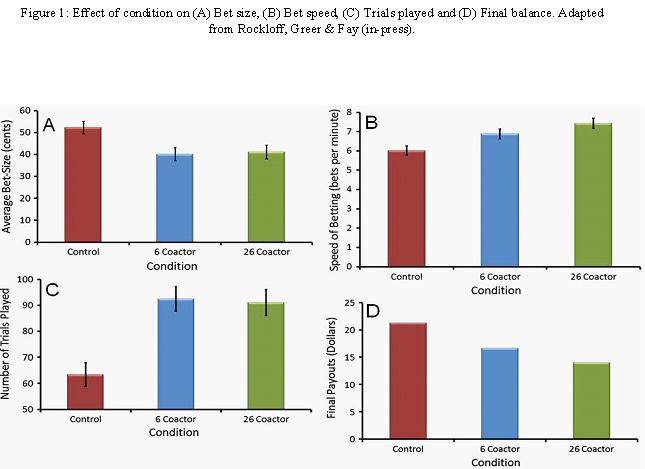The WAGER, Vol 15(9): Audience participation? The effect of co-actors on Electronic Slot Machine gambling
Many factors can affect people’s gambling behaviors. Researchers are exploring the social facilitation effect as a potential influence on gambling behavior. The social facilitation effect states that the presence of bystanders increases performance on simple tasks (Zajonc, 1965).This week’s WAGER examines whether the social facilitation effect is applicable to electric slot machine (ESM) gambling (Rockloff, Greer, & Fay, in-press).
Methods
- One hundred and thirty-five participants (60% female) who responded to local newspaper advertisements in Queensland, Australia participated in the study.
- Researchers told participants that they would participate engage in ESM gambling with others teleconferenced from a remote site. The “teleconference” was one of two pre-recorded videos [1].
- Researchers randomized participants into three groups: 0-, 6- and 26-co-gamblers: no co-gamblers or a pre-recorded video of either five or 25 co-gamblers and one live confederate co-gambler in the same room playing ESMs.
- Researchers awarded participants AU$20 to participate in the study and invited them to use this $20 as starting funds for the ESM [2].
- Researchers programmed ESMs to provide a rapid win-sequence followed by unlimited losses. Confederates’ ESMs gave a winning spin about every three minutes per machine.
- Participants could cash out at any time by pressing a buzzer. The experiment ended upon cash out or exhaustion of the initial $20.
- Researchers assessed participants’: bet size, bet speed, total bets and end balance.
Results
- Researchers found significant main effects of condition on bet size, F (2, 118) = 5.33, p = .01; betting speed, F (2, 118) = 8.21, p < .01; total number of bets, F (2, 118) = 12.52, p < .001; and end balance, F (2, 127) = 7.64, p = .001.
- Pairwise comparisons revealed that participants in the six-co-gambler group bet less money per bet, p = .004; bet faster, p = .01; played more trials, p < .001; and ended with less money, p = .002 [3] compared to those who bet alone. Researchers found no significant differences between the six- and 26-co-gambler conditions and made no comparisons between the alone and 26-co-gambler groups. See Figure 1.

Limitations
- This study has limited external validity because, although the ESMs made typical sounds, participants completed the study in a computer lab setting without any other visual stimuli typically inherent within casino environments.
- Participants were aware of potential monitoring by researchers and might have adjusted their playing habits accordingly.
- ESMs are relatively simple to play compared to other casino games: There is little strategy involved and there are no complex betting rules. The findings might not be generalizable to other games.
Conclusions
This study lends some preliminary support to the idea that the presence of others can intensify simple gambling behavior – at least under experimental conditions. Even a small number of co-gamblers can create a social facilitation effect. However, it is unclear whether this effect can be attributed to the social facilitation effect, as previous other research has shown that the frequency of winning cues also can change gambling behaviors in similar ways (Rockloff & Dyer, 2007). This research might have implications for casino design and perhaps regulation; most gambling venues are extremely large and serve many people at any one time, raising individuals’ chances for ongoing participation in simple casino games.
-Daniel Tao
What do you think? Please use the comment link below to provide feedback on this article.
References
- Rockloff, M., & Dyer, V. (2007). An experiment on the social facilitation of gambling behavior. Journal of Gambling Studies, 23(1), 1-12.
- Rockloff, M. J., Greer, N., & Fay, C. (in-press). The social congagion of gambling: How venue size contributes to player losses. . Journal of Gambling Studies.
- Zajonc, R. B. (1965). Social facilitation. Science, 149(3681), 269-274.
[1] Three participants doubted the validity of the ‘teleconference’. Researchers excluded data from these participants.
[2] All participants agreed to use their reward funds.
[3] No means or Fs reported for pairwise comparisons.